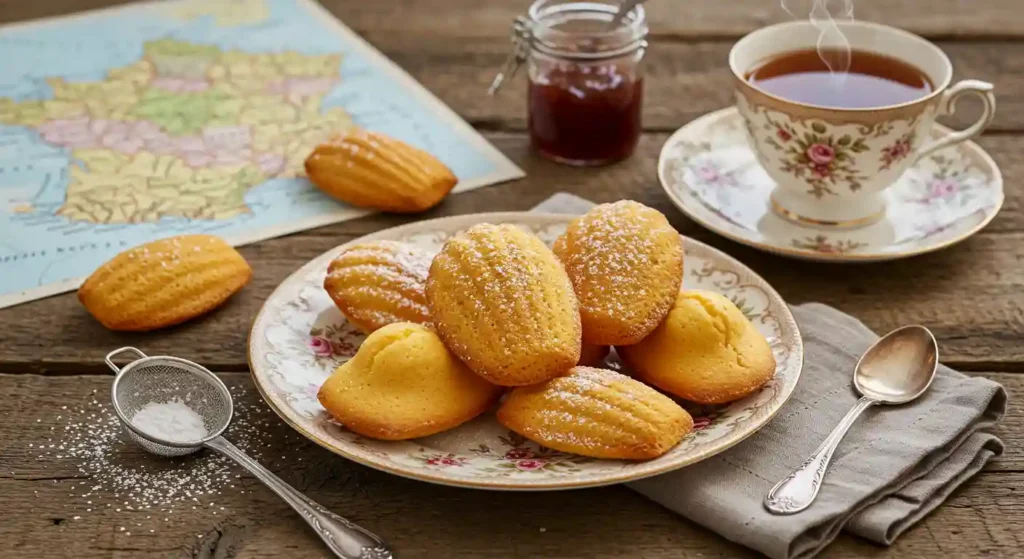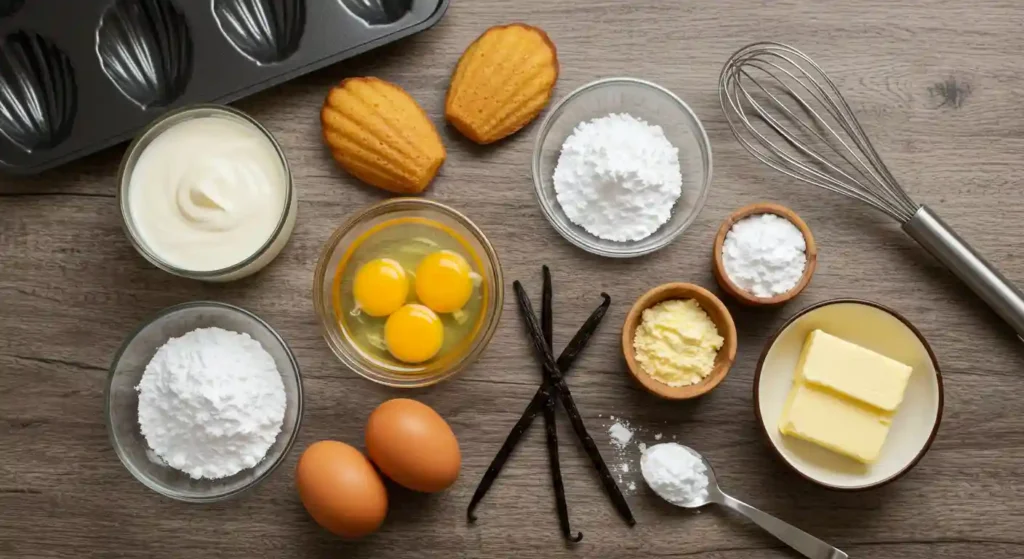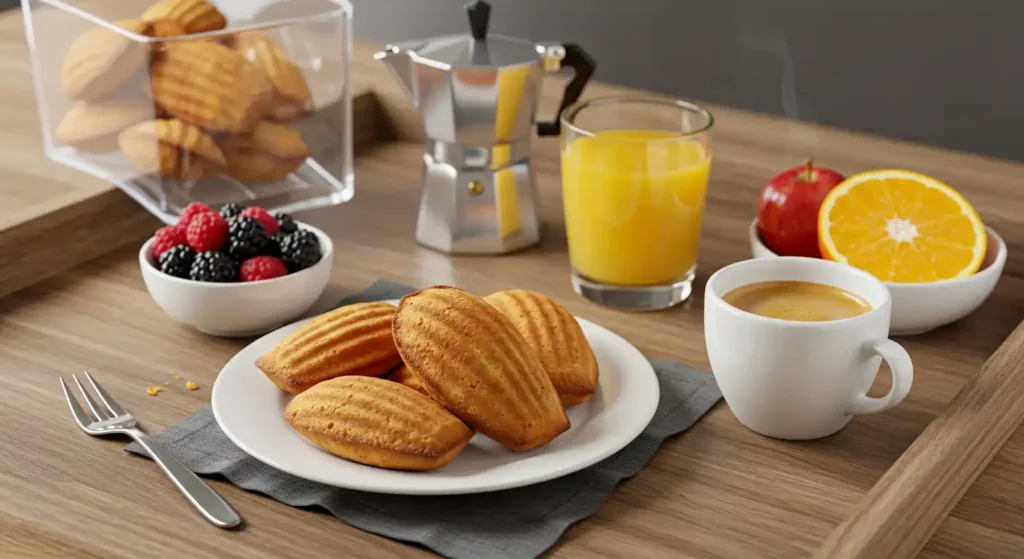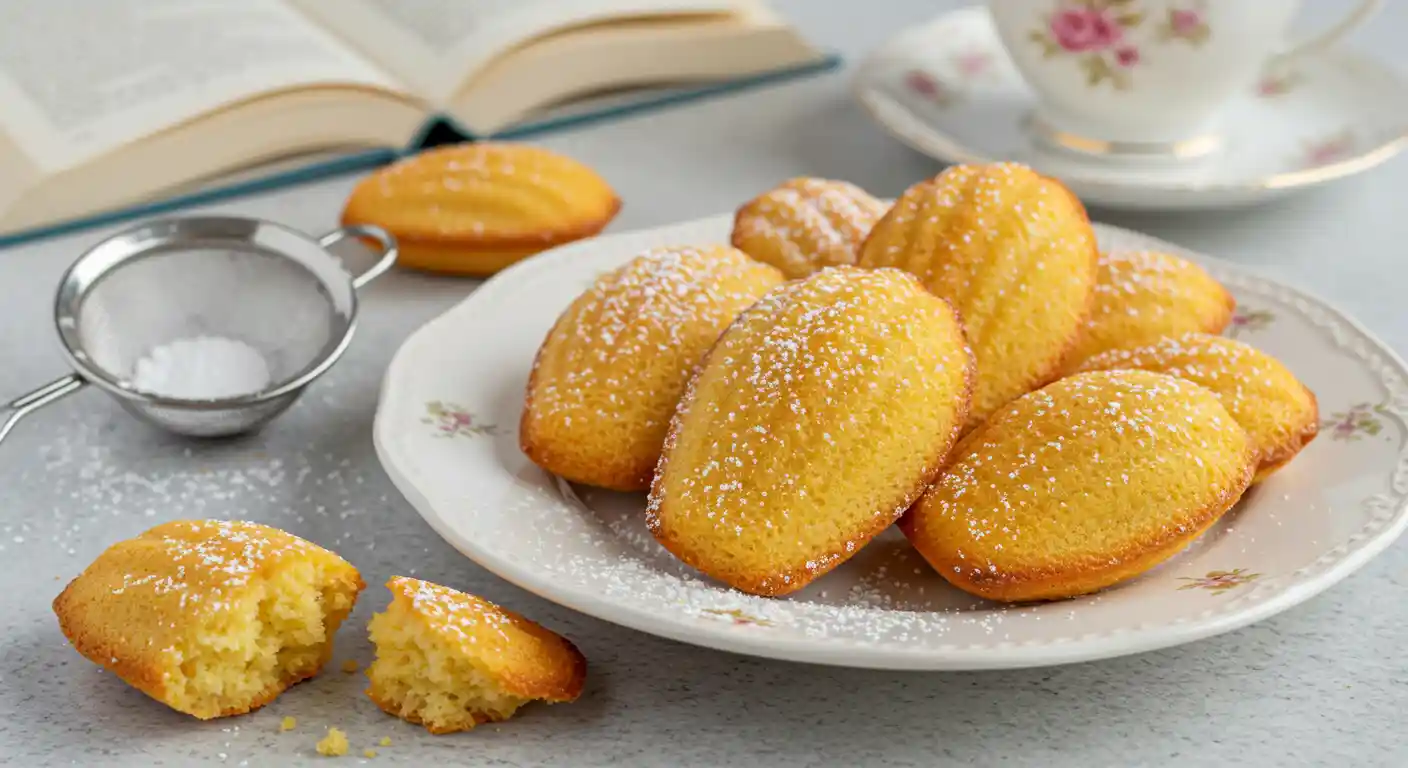Madeleine cookies recipe using cream has its roots deeply embedded in French history, with origins dating back to the Lorraine region. The story of these iconic treats is intertwined with that of Madeleine Paulmier, a servant who allegedly presented them to King Louis XV, thus beginning their royal association. Over centuries, the Madeleine has become a symbol of French refinement. The version that incorporates cream brings a rich, moist texture to the pastry, setting it apart from its simpler predecessors. Today, this luxurious variation continues to delight dessert lovers, reflecting the enduring charm and elegance of French pastry craftsmanship.
Table of Contents
Why Cream Makes These Madeleines Irresistible
The addition of cream to a Madeleine cookies recipe using cream transforms these delicate pastries into an indulgent delight. Cream introduces a rich, velvety texture, ensuring the Madeleines are tender with each bite. Its fat content contributes to a moist crumb, enhancing both flavor and mouthfeel. The subtle richness of the cream complements the buttery notes of the dough, balancing the sweetness without overpowering it. Additionally, the cream helps create a slight density, giving the cookies a satisfying heft, yet retaining their lightness. This harmonious blend of flavors and textures makes Madeleines made with cream utterly irresistible to the palate.

Understanding the Key Ingredients
The Role of Butter and Cream in Madeleine Dough
In a Madeleine cookies recipe using cream, both butter and cream play crucial roles in shaping the dough’s texture and flavor profile. Butter lends a rich, luxurious taste, creating a delicate crumb that is both airy and tender. It imparts a golden color and enhances the overall flavor complexity. Cream, on the other hand, adds moisture and a soft, melt-in-your-mouth quality to the dough. The combination of these ingredients results in a harmonious balance between richness and lightness. This union ensures that the Madeleines retain their characteristic softness while offering a satisfying, indulgent bite with each mouthful.
Why Flour Type Matters for a Perfect Texture
In a Madeleine cookies recipe using cream, the choice of flour significantly influences the final texture. For optimal results, soft flour, such as cake flour, is ideal due to its low protein content. This creates a finer, lighter crumb that enhances Madeleine’s delicate nature. Higher-protein flours, like all-purpose flour, can result in a denser, tougher texture, which may interfere with the airy, melt-in-your-mouth quality that defines a perfect Madeleine. By selecting the right flour, bakers can achieve a soft, tender texture that complements the rich flavor of butter and cream, ensuring a flawless result.
The Magic of Fresh Eggs for Lightness and Flavor
In a Madeleine cookies recipe using cream, fresh eggs are essential for both lightness and flavor. The proteins in fresh eggs help to provide structure, while the yolks contribute richness, adding depth to the flavor profile. When whipped, the eggs incorporate air into the batter, creating a delicate, airy texture that is crucial for the perfect Madeleine. Additionally, fresh eggs enhance the overall taste, imparting a subtle, natural sweetness that complements the cream’s richness. This combination ensures that the Madeleines rise beautifully and maintain a soft, tender crumb, elevating the pastry to an irresistible treat.
The Importance of Sugar for Sweetness and Structure
In a Madeleine cookies recipe using cream, sugar is pivotal not only for sweetness but also for the structural integrity of the cookies. Sugar contributes to the Maillard reaction during baking, enhancing the golden-brown color and creating a slightly crisp exterior. Its hygroscopic nature helps retain moisture, keeping the Madeleines soft and tender. Moreover, sugar stabilizes the batter, aiding in the perfect rise while allowing the cookies to hold their shape. The balance of sugar ensures the right level of sweetness without overpowering the delicate cream and butter flavors, creating a harmonious and well-rounded treat.
Essential Equipment for Baking Madeleines
Choosing the Right Madeleine Pan
Choosing the right Madeleine pan is crucial for achieving the signature shape and texture in a Madeleine cookies recipe using cream. A high-quality, non-stick pan ensures easy removal and consistent results. Look for pans with deeper indentations, as these will help form the iconic shell shape while allowing the batter to rise evenly. Metal pans, particularly those made of aluminized steel, conduct heat efficiently, resulting in a perfectly golden crust. Avoid overly thick pans, which may lead to uneven baking, compromising the final texture of your Madeleines.
Essential Tools for Mixing and Preparing the Batter
For a flawless Madeleine cookies recipe using cream, having the right tools is essential. A stand mixer or handheld electric whisk will efficiently blend the butter, cream, and sugar, ensuring a smooth, airy batter. A fine sieve is crucial for sifting flour, preventing clumps, and ensuring a light texture. A rubber spatula is perfect for gently folding in the dry ingredients, maintaining airiness. Additionally, a kitchen scale ensures precise measurements, allowing for consistent results and the perfect Madeleine every time.
Optional Tools to Elevate Your Madeleine Presentation
To elevate the presentation of a Madeleine cookies recipe using cream, consider using a fine pastry brush to lightly glaze the Madeleines with melted butter or citrus syrup for added shine. A delicate dusting of powdered sugar or a drizzle of chocolate ganache can enhance both flavor and visual appeal. For a more refined touch, use a small piping bag to add a decorative swirl of cream or a fruit compote on top, turning your Madeleines into an elegant, gourmet treat.

Step-by-Step Guide to Baking Madeleines with Cream
Preparing the Batter: Mixing Wet and Dry Ingredients
In a Madeleine cookies recipe using cream, preparing the batter involves carefully mixing the wet and dry ingredients for a smooth, airy texture. Start by creaming the softened butter with sugar until light and fluffy. Add eggs one at a time, ensuring each is fully incorporated before the next. Gently fold in the cream to achieve a rich, velvety consistency. In a separate bowl, sift together flour and a pinch of salt. Gradually incorporate the dry ingredients into the wet mixture, using a spatula to avoid deflating the batter. The result should be smooth, yet airy, ensuring light and tender Madeleines.
Folding in the Cream for a Silky Smooth Dough
In a Madeleine cookies recipe using cream, folding in the cream is a crucial step for achieving a silky smooth dough. After incorporating the other ingredients, gently add the cream to the mixture. Use a spatula to carefully fold the cream in, scraping from the bottom and lifting the batter. This technique ensures that the cream blends evenly without deflating the batter’s airiness. The result is a rich, velvety consistency that will bake into light and tender Madeleines. This step is essential for enhancing the texture, providing the perfect balance of richness and softness in every bite.
The Secret to Perfectly Shaping Your Madeleines
The secret to perfectly shaping your Madeleines lies in a Madeleine cookies recipe using cream and the proper technique. Start by greasing your Madeleine pan thoroughly, ensuring the batter doesn’t stick during baking. To achieve the signature shell shape, fill each indentation with just the right amount of batter—about two-thirds full. Overfilling can cause the Madeleines to lose their delicate form. It’s also essential to let the batter rest before baking; this allows the dough to firm up, giving the Madeleines their characteristic hump. Consistent, precise shaping ensures a uniform texture and a beautiful, golden finish.
Resting Time: Why It’s Crucial for Texture and Flavor
Resting time is essential in a Madeleine cookies recipe using cream to achieve the ideal texture and flavor. Allowing the batter to rest for at least 30 minutes, or even overnight, helps the flour fully absorb the wet ingredients, resulting in a smoother, more cohesive dough. This resting period allows the gluten to relax, contributing to the signature light and airy texture of the Madeleines. Additionally, the flavors have time to meld, enhancing the overall taste. Without this crucial step, the cookies may lack the desired tenderness and flavor depth that makes them truly irresistible.
Baking Tips for Perfect Madeleines Every Time
Ideal Oven Temperature for a Fluffy and Golden Madeleine
The ideal oven temperature for a Madeleine cookies recipe using cream is crucial for achieving the perfect fluffy, golden texture. Preheat the oven to 375°F (190°C) to ensure that the Madeleines bake evenly and develop a beautifully crisp exterior while maintaining a soft, airy interior. Too high a temperature can result in an over-browned exterior and an undercooked center. Conversely, a lower temperature may lead to uneven rising, affecting both texture and flavor. By maintaining the right temperature, the Madeleines will puff up with a delicate golden hue, delivering the perfect balance of crispness and tenderness.
How to Prevent Overbaking or Undercooking
To prevent overbaking or undercooking in a Madeleine cookies recipe using cream, precision is key. Start by preheating the oven to the ideal temperature of 375°F (190°C), as consistent heat is essential for even baking. Keep a close eye on the Madeleines as they bake, checking for a golden-brown color along the edges. If the tops spring back when lightly pressed, they’re done. Avoid opening the oven door frequently, as it can cause fluctuations in temperature. To ensure uniform baking, place the pan in the center of the oven. Proper timing and attention will ensure perfectly baked Madeleines every time.
Tips for Achieving the Signature Madeleine “Hump”
Achieving the signature Madeleine “hump” is a hallmark of a perfect Madeleine cookies recipe using cream. To create this iconic rise, start by chilling the batter for at least 30 minutes before baking. This resting period allows the dough to firm up, ensuring it holds its shape in the oven. Another key tip is to fill the Madeleine pan only two-thirds full, leaving room for the batter to expand. Bake at the ideal temperature of 375°F (190°C) to ensure a rapid rise. Finally, avoid opening the oven door during the first few minutes of baking to maintain the heat and encourage the “hump” to form.


Classic Madeleine Cookies Recipe Using Cream
Equipment
- Madeleine pan
- Whisk or electric mixer
- Mixing bowl
- Wire rack
- Spoon or piping bag
Ingredients
- 2 large eggs
- ⅓ cup granulated sugar
- ½ teaspoon vanilla extract
- ½ cup all-purpose flour
- ¼ teaspoon baking powder
- Pinch of salt
- ¼ cup unsalted butter melted and cooled
- ¼ cup heavy cream
- Powdered sugar for dusting
Instructions
Prepare Equipment:
- Preheat the oven to 375°F (190°C) and grease the Madeleine pan with butter or non-stick spray.
Mix Batter:
- Whisk eggs and sugar until pale and frothy. Add vanilla, sifted flour, baking powder, and salt. Gently fold in melted butter and heavy cream until the batter is smooth.
Rest the Batter:
- Let the batter rest in the refrigerator for 20–30 minutes to enhance texture and flavor.
Fill Molds:
- Spoon or pipe batter into the Madeleine pan, filling each mold about ¾ full.
Bake:
- Bake for 8–10 minutes or until edges are golden and centers puffed with the signature hump.
Cool and Serve:
- Remove Madeleines from the pan, cool on a wire rack, and dust with powdered sugar before serving.
Notes
- Let the batter rest for 20–30 minutes to achieve the signature hump.
- Use room-temperature ingredients for the best consistency.
- Bake at a properly preheated oven (375°F/190°C) for even rising.
Finishing Touches: Serving and Storing Your Madeleines
Dusting with Powdered Sugar or Adding a Glaze
For an elegant finish to a Madeleine cookies recipe using cream, dusting with powdered sugar or adding a glaze can elevate the appearance and flavor. A light dusting of powdered sugar imparts a delicate sweetness without overpowering the buttery richness of the Madeleines. For a more decadent touch, drizzle a simple glaze made from powdered sugar and lemon juice, or a chocolate glaze for a luxurious contrast. The glaze not only enhances the flavor but also adds a glossy, refined look, making the Madeleines even more irresistible and perfect for special occasions or a sophisticated treat.
Serving Suggestions to Pair with Madeleines
A Madeleine cookies recipe using cream pairs beautifully with a variety of beverages and accompaniments. For a classic pairing, enjoy Madeleines with a hot cup of tea, such as Earl Grey or a light green tea, which complements the delicate flavors. Alternatively, serve them alongside a rich cappuccino or freshly brewed coffee for a more indulgent experience. For a summery twist, pair them with a glass of chilled lemonade or a fruity iced tea. A dollop of whipped cream or a scoop of vanilla ice cream can also elevate the Madeleines, adding a creamy contrast to their light texture.
How to Store Leftover Madeleines to Keep Them Fresh
To keep your Madeleine cookies recipe using cream fresh, store the leftovers in an airtight container at room temperature. This helps retain their delicate texture, keeping them soft and moist. If you need to store them for a longer period, consider freezing them. Place the Madeleines on a baking sheet in a single layer to freeze them initially, then transfer them to a freezer-safe container or bag once firm. To refresh them, simply warm them in the oven for a few minutes. This ensures they regain their tender, melt-in-your-mouth consistency, even after being stored.
- If you love this Madeleine cookies recipe using cream, you’ll also enjoy our bow arrow cupcakes recipe for the perfect flaky treat.

Variations and Creative Twists on the Classic Madeleine Recipe
Adding Flavors: Vanilla, Lemon, and Almond
Adding flavors to a Madeleine cookies recipe using cream is a wonderful way to personalize these delicate treats. Vanilla, with its rich, aromatic essence, is a classic addition that enhances the buttery base of the Madeleines. For a citrusy twist, lemon zest or a splash of lemon juice imparts a fresh, vibrant note, balancing the cream’s richness. Almond extract, on the other hand, introduces a warm, nutty flavor that complements the softness of the cookies. These flavorings can be adjusted to taste, allowing you to create a variety of Madeleine variations suited to different preferences and occasions.
Incorporating Chocolate or Fruit into the Dough
Incorporating chocolate or fruit into a Madeleine cookies recipe using cream can add a delightful twist to these traditional treats. For chocolate lovers, folding in finely chopped chocolate or cocoa powder creates a rich, indulgent flavor. Alternatively, fresh berries or dried fruits, such as raspberries or cranberries, can be gently folded into the dough for a burst of sweetness and color. When adding these ingredients, be sure not to overmix the batter to preserve the light, airy texture of the Madeleines. These additions will provide a unique and flavorful variation while maintaining the signature tender crumb.
Using Different Types of Cream for a Richer Taste
Using different types of cream in a Madeleine cookies recipe using cream can elevate the richness and depth of flavor. Heavy cream or double cream offers a luxurious texture, resulting in an ultra-soft, moist crumb. For a slightly lighter but still decadent version, opt for whipping cream, which adds a delicate richness without overwhelming the cookies. For an even more indulgent twist, you can experiment with flavored creams, such as vanilla-infused or chocolate cream, to infuse the Madeleines with subtle aromatic notes. The choice of cream can dramatically influence the taste, offering a variety of delicious, creamy nuances.
Frequently Asked Questions (FAQs)
What’s the secret to keeping Madeleines soft and moist?
The key to keeping Madeleines moist is incorporating heavy cream into the batter, which adds extra richness and moisture. Proper storage is also essential—keep them in an airtight container at room temperature to preserve their texture. For longer storage, freezing the cookies helps maintain their freshness.
Are there substitutes for a Madeleine pan?
If you don’t have a Madeleine pan, you can use small muffin tins or shallow tart pans to create cookies of similar size and shape. While they won’t have the iconic shell design, the flavor and texture will still shine. Line the molds with parchment or grease them well to ensure easy release.
What makes Madeleine’s cookies so irresistible?
Madeleines combine a buttery, rich flavor with a light, sponge-like texture that melts in your mouth. Their delicate appearance and versatility as a tea-time treat or dessert make them an elegant indulgence. When made with cream, they become even softer and more luxurious.
How does creaming work in a cookie recipe?
Creaming involves beating sugar and eggs (or sometimes butter) together to incorporate air, creating a light and fluffy batter. This process helps Madeleines achieve their signature delicate sponge texture. Proper creaming is essential for ensuring the cookies rise evenly and have a tender crumb.
How are Madeleines traditionally enjoyed in France?
In France, Madeleines are typically enjoyed as a simple yet elegant snack with coffee or tea. They are often served plain or lightly dusted with powdered sugar, making them a staple of French tea-time culture. Their small size and refined flavor make them perfect for casual or formal gatherings.
Why is it important to chill Madeleine’s batter?
Chilling Madeleine batter helps to firm it up, which improves the texture and prevents spreading during baking. It also allows the flavors to meld and enhances the batter’s ability to create the iconic hump. This step ensures a better rise and a beautifully shaped cookie.
Wrapping Up
The Madeleine cookies recipe using cream is a delightful twist on a traditional French pastry, delivering cookies that are irresistibly soft, tender, and full of flavor. By incorporating cream, you achieve a richer moist cookie texture that enhances every bite, while still preserving the iconic delicate sponge and buttery goodness of these classic French butter cookies.
Whether you’ve followed our simple baking instructions for a traditional batch or experimented with vanilla-infused or citrus variations, these cookies are sure to become a favorite for any occasion—from a cozy tea-time dessert to a stunning addition to your breakfast or dessert table.
We’d love to hear about your homemade baking journey! Did the cream make your Madeleines extra fluffy? Did you try any flavor twists or presentation ideas? Share your baking stories, tips, and photos in the comments below—because nothing inspires more than the joy of a freshly baked batch of Madeleines!


2 thoughts on “Irresistibly Madeleine cookies recipe using cream”